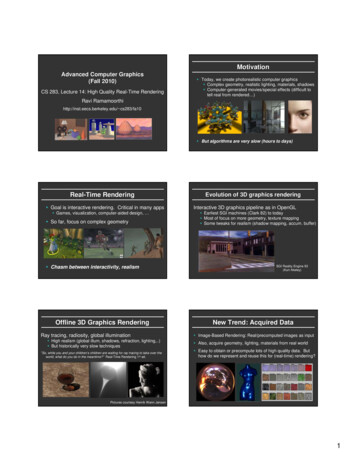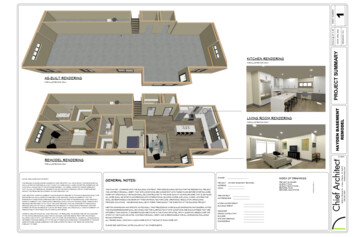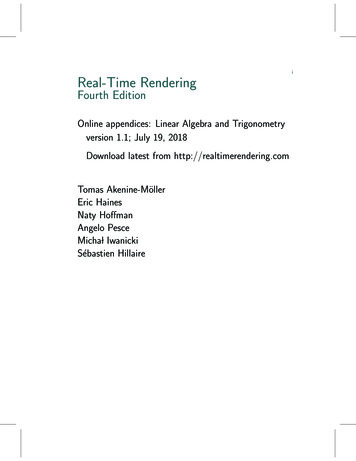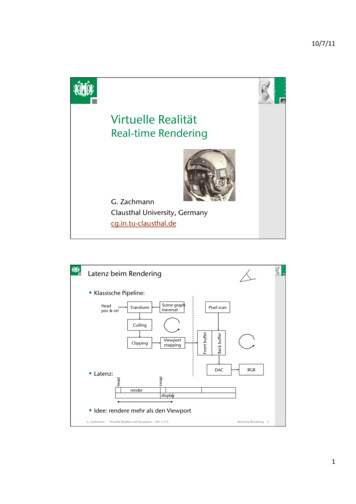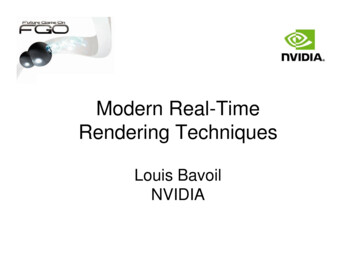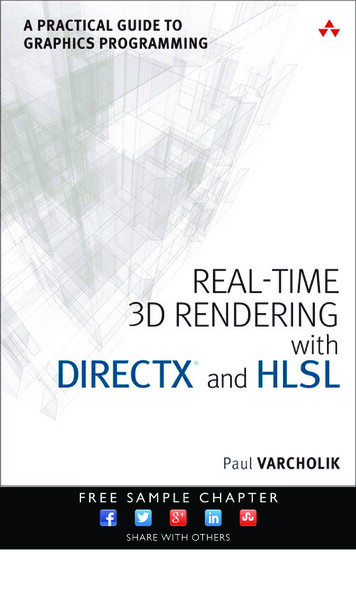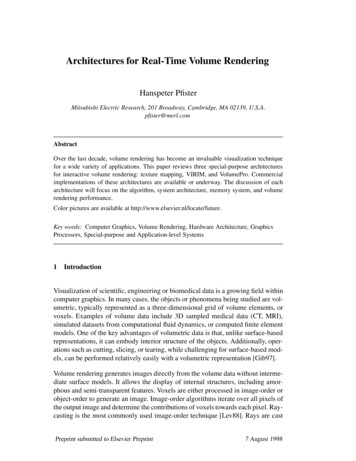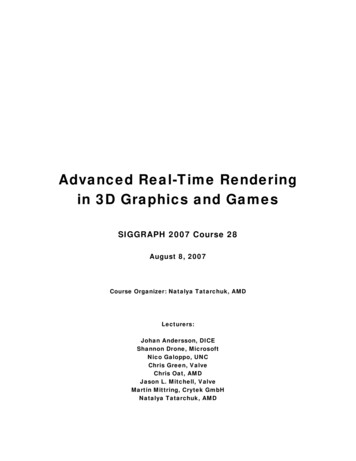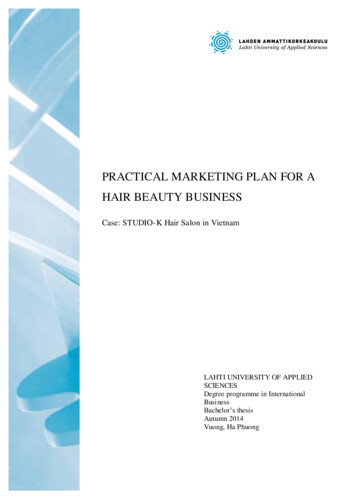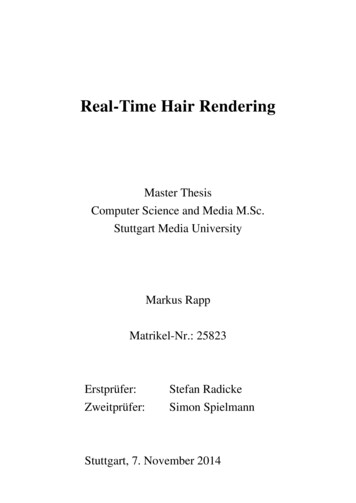
Transcription
Real-Time Hair RenderingMaster ThesisComputer Science and Media M.Sc.Stuttgart Media UniversityMarkus RappMatrikel-Nr.: 25823Erstprüfer:Zweitprüfer:Stefan RadickeSimon SpielmannStuttgart, 7. November 2014
Real-Time Hair RenderingAbstractAbstractAn approach is represented to render hair in real-time by using a small number of guidestrands to generate interpolated hairs on the graphics processing unit (GPU). Hairinterpolation methods are based on a single guide strand or on multiple guide strands.Each hair strand is composed by segments, which can be further subdivided to rendersmooth hair curves. The appearance of the guide hairs as well as the size of the hairsegments in screen space are used to calculate the amount of detail, which is needed todisplay smooth hair strands. The developed hair rendering system can handle guidestrands with different segment counts. Included features are curly hair, thinning andrandom deviations. The open graphics library (OpenGL) tessellation rendering pipelineis utilized for hair generation.The hair rendering algorithm was integrated into the Frapper’s character renderingpipeline. Inside Frapper, configuration of the hair style can be adjusted. Developmentwas done in cooperation with the Animation Institute of Filmakademie BadenWürttemberg within the research project “Stylized Animations for Research on Autism”(SARA).Keywords: thesis, hair, view-dependent level of detail, tessellation, OpenGL, Ogre,Frapperi
Real-Time Hair RenderingDeclaration of OriginalityDeclaration of OriginalityI hereby certify that I am the sole author of this thesis and that no part of this thesis hasbeen published or submitted for publication.I certify that, to the best of my knowledge, my thesis does not infringe upon anyone’sCopyright nor violate any proprietary rights and that any ideas, techniques, quotations,or any other material from the work of other people included in my thesis, published orotherwise, are fully acknowledged in accordance with the standard referencingpractices.I confirm that I understand the meaning of the affidavit and the legal consequences forexamination (§ 19 Abs. 2 Master-SPO of Stuttgart Media University) as well ascriminal law (§ 156 StGB) for a wrong or incomplete affidavit.Markus Rapp, 7. November 2014ii
Real-Time Hair RenderingAcknowledgementsAcknowledgementsThis work has been carried out in the German Research Foundation (DFG) fundedproject SARA (AR 892/1-1).I want to say thank you to the Animation Institute of Filmakademie BadenWürttemberg, who gave me the chance to implement a tessellation based, real-time hairrendering system for their research project SARA. Thank you for the support of theR&D department including Volker Helzle, Diana Arellano, Simon Spielmann and KaiGötz.I also want to say thank you to my family, who supported me financially over my wholestudy time.Finally, I want to say thank you to all professors and employees of Stuttgart MediaUniversity and University of Abertay Dundee, who taught me a lot at my studies.Without the skills I got from the lectures and coursework, making this thesis would nothave been possible.iii
Real-Time Hair RenderingContentsContentsAbstract . iDeclaration of Originality. iiAcknowledgements . iiiContents . iv1. Introduction. 12. Related Work . 32.1. NVIDIA Fermi Hair Demo 2008 . 52.2. NVIDIA HairWorks. 102.3. AMD TressFX . 113. Requirements. 174. OpenGL Tessellation Rendering Pipeline. 194.1. Vertex Shader . 204.2. Tessellation Control Shader . 214.3. Tessellator . 224.4. Tessellation Evaluation Shader . 234.5. Geometry Shader . 244.6. Fragment Shader. 264.7. Tessellation Primitive Isolines . 275. Implementation . 315.1. Input Data. 325.2. Single Strand Interpolation . 335.3. Multi Strand Interpolation . 365.4. Combination of Single Strand and Multi Strand Interpolation. 385.5. Handling Different Hair Guide Sizes . 395.6. Expand Lines into Camera Facing Quads . 415.7. Hair Form . 425.8. Hair Strand Tessellation . 435.8.1. Hermite Curve Interpolation . 435.8.2. Uniform Cubic B-Splines . 455.9. Curly Hair . 475.10. Thinning . 485.11. Random Deviations . 51iv
Real-Time Hair RenderingContents5.12. Level of Detail . 535.12.1. Screen Space Adaptive Level of Detail . 545.12.2. Hair Culling. 555.13. Hair Shading . 566. Character Rendering System Integration . 596.1. Hair Geometry. 596.2. Hair LOD . 616.3. Hair Lighting . 626.4. Light Definition . 627. Hair Rendering Performance Analysis . 638. Conclusion. 708.1. Future Work . 719. References . 7310. List of Figures . 7811. List of Tables . 8112. List of Abbreviations . 82v
Real-Time Hair Rendering1. Introduction1. IntroductionReal-time hair rendering has been a huge challenge in the games industry and forsimulation applications. On a human head are up to 150000 hairs. Main challenge is tobe able to render this huge amount of hair strands in real-time. With modern graphicsprocessors it becomes possible to render thousands of hair strands on the GPU. How canmodern graphics cards be utilized for hair rendering? Is it possible today to renderrealistic hair in real-time?These questions were answered within the research project SARA for Institute ofAnimation of Filmakademie Baden-Württemberg. The official name of the project is“Impact of non-photorealistic rendering for the understanding of emotional facialexpressions by children and adolescents with high-functioning Autism SpectrumDisorders”. The project deals with the creation and animation of computer-generatedfacial expressions in different levels of abstraction for the purpose of investigating howthese different facial expressions are perceived by subjects with AttentionDeficit/Hyperactivity Disorder (ADHD) and Autism Spectrum Disorders (ASD).Filmakademie Baden-Württemberg cooperates for this research project with Universityof Konstanz and University Hospital Freiburg. The project is funded by DFG.One area of the project is the rendering of realistic hair in real-time. For hair renderingthere is already an implementation. The implementation uses predefined geometry. Forevery single hair strand vertices, normals, tangents and texture coordinates are stored ina mesh file. This leads to a huge amount of data, which needs to be loaded, transferredto GPU memory and rendered.Target of this thesis is to research different techniques to reduce the amount of data thatneeds to be stored and to increase the frame rate for rendering the virtual character. It isinvestigated how hair geometry can be directly generated on the GPU. The idea is to usea small number of guide strands and generate new hair strands out of these guides.Techniques are compared, which use a single guide strand as well as multiple guidestrands as input. Different distribution patterns and randomization techniques for theposition of hair and shape of hair are tried out. It is investigated how level of detail(LOD) techniques can be utilized to be able to render smooth hair strands and at thesame time save processing resources for an increased frame rate. Additionally, hairshading techniques are evaluated for rendering of realistic hair.Related work, which already has been done in real-time hair rendering is analysed insection 2. Afterwards, requirements for the development of the hair rendering systemare described. In section 4 the features and functionality OpenGL tessellation renderingpipeline are shown. Section 5 focuses on the implementation of the hair renderingsystem. Topic in section 6 is the integration of the developed hair rendering system into1
Real-Time Hair Rendering1. Introductionthe character rendering system of the Frapper framework. In the following section theperformance of the developed hair rendering system is tested and compared againstrelated work. The final section concludes this thesis and points out possible areas offuture research.2
Real-Time Hair Rendering2. Related Work2. Related WorkIn the past, real-time hair rendering could only be done with a mesh representation ofthe hair on which a material was applied.Figure 1: Hair rendering of Ruby by [Scheuermann 2004]One attempt to put hair on a human mesh was done by [Scheuermann 2004] of ATIResearch and presented at Siggraph 2004. Scheuermann’s approach is based on the hairshading model of [Kajiya and Kay 1989] and specular highlights model of [Marschneret al. 2003]. The hair model consisted of two-dimensional (2D) layered polygon patcheswith a main texture for the structure and an opacity map for the diversity of the hair. 2Dlayered polygon patches were used instead of lines because they have a low geometriccomplexity, which reduced load for the vertex shader. Shading was done with a diffuselighting term, two specular highlights and ambient occlusion. The first specularhighlight is the direct reflection of the light. The second specular highlight istransmitted into the hair in direction of the root and internally reflected back to theviewer. As a result, the colour of the second specular highlight is modulated by the haircolour and the shape of the highlight is depolarized. Additional calculations need to beexecuted for depth sorting, which is done entire
Real-Time Hair Rendering 2. Related Work 3 2. Re la te d Wor k In the past, real-time hair rendering could only be done with a mesh representation of the hair on which a material was applied. Figure 1: Hair rendering of Ruby by [Scheuermann 2004] One attempt to put hair on a human mesh was done by [Scheuermann 2004] of ATI
